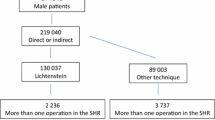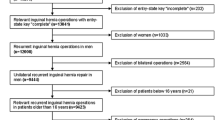Abstract
Background
According to the Swedish Hernia Register (SHR), the reoperation rate is more than doubled after recurrent groin hernia repair compared with primary repair. The aim was to study the impact of type of mesh repair used in recurrent groin hernia surgery on a 2nd recurrence in a population-based cohort derived from the SHR.
Material and method
All 1st recurrent hernia repairs in the south-west region of Sweden, registered in SHR between 1998 up to 2007 were included. A questionnaire was sent in 2009. Patients stating a new lump or persisting problems were examined. A 2nd recurrence was identified as a 2nd reoperation or at physical examination. The incidence was analysed comparing anterior mesh repair (AMR) and posterior mesh repairs (PMR) (endoscopic and open).
Results
Eight hundred and fifteen recurrent operations in 767 patents were analysed, 401 AMRs and 414 PMRs. PMR had a lower 2nd recurrence rate compared with AMR (5.6 vs. 11.0 %) (p = 0.025). An increased risk [3.21 (CI 1.33–7.44) (p = 0.009)] of a subsequent 2nd recurrence was seen after anterior index repair followed by AMR and a decreased risk [0.08 (CI 0.01–0.94) (p = 0.045)] after posterior index repair followed by AMR.
Conclusion
PMR in recurrent groin hernia surgery was associated with a lower 2nd recurrence rate compared to anterior. A posterior approach for 1st recurrent operation is recommended after an anterior index repair and an anterior approach after a posterior index operation.



Similar content being viewed by others
References
SHR (Swedish Hernia Register) web site, www.svensktbrackregister.se/index.php?lang=en. Accessed Nov 2014
Karthikesalingam A, Markar SR, Holt PJ, Praseedom RK (2010) Meta-analysis of randomized controlled trials comparing laparoscopic with open mesh repair of recurrent inguinal hernia. Br J Surg 97:4–11
Sevonius D, Gunnarsson U, Nordin P, Nilsson E, Sandblom G (2009) Repeated groin hernia recurrences. Ann Surg 249:516–518
Sevonius D, Gunnarsson U, Nordin P, Nilsson E, Sandblom G (2011) Recurrent groin hernia surgery. Br J Surg 98:1489–1494
Bisgaard T, Bay-Nielsen M, Kehlet H (2008) Re-recurrence after operation for recurrent inguinal hernia. A nationwide 8-year follow-up study on the role of type of repair. Ann Surg 247:707–711
Saber A, Ellabban GM, Gad MA, Elsayem K (2012) Open preperitoneal versus anterior approach for recurrent inguinal hernia: a randomized study. BMC Surg 12:22
Simons MP et al (2009) European Hernia Society guidelines on the treatment of inguinal hernia in adult patients. Hernia 13:343–403
Miserez M et al (2014) Update with level 1 studies of the European Hernia Society guidelines on the treatment of inguinal hernia in adult patients. Hernia 18:151–163
Haapaniemi S, Nilsson E (2002) Recurrence and pain three years after groin hernia repair. Validation of postal questionnaire and selective physical examination as a method of follow-up. Eur J Surg 168:22–28
Nyhus LM (1989) The recurrent groin hernia: therapeutic solutions. World J Surg 13:541–544. doi:10.1007/BF01658868
Wantz GE (1989) Giant prosthetic reinforcement of the visceral sac. Surg Gynecol Obstet 169:408–417
Stoppa R, Petit J, Henry X (1975) Unsutured Dacron prosthesis in groin hernias. Int Surg 60:411–412
Maillart JF, Vantournhoudt P, Piret-Gerard G, Farghadani H, Mauel E (2011) Transinguinal preperitoneal groin hernia repair using a preperitoneal mesh preformed with a permanent memory ring: a good alternative to Lichtenstein’s technique. Hernia 15:289–295
Kouhia ST et al (2009) Lichtenstein hernioplasty versus totally extraperitoneal laparoscopic hernioplasty in treatment of recurrent inguinal hernia—a prospective randomized trial. Ann Surg 249:384–387
Dedemadi, G., et al. Recurrent Inguinal Hernia Repair: What is the Evidence of Case Series? A Meta-Analysis and Metaregression Analysis. Surgical laparoscopy, endoscopy & percutaneous techniques (2014)
Magnusson N, Nordin P, Hedberg M, Gunnarsson U, Sandblom G (2010) The time profile of groin hernia recurrences. Hernia 14:341–344
Schouten N et al (2012) Female ‘groin’ hernia: totally extraperitoneal (TEP) endoscopic repair seems the most appropriate treatment modality. Hernia 16:387–392
Koch A, Edwards A, Haapaniemi S, Nordin P, Kald A (2005) Prospective evaluation of 6895 groin hernia repairs in women. Br J Surg 92:1553–1558
Mikkelsen T, Bay-Nielsen M, Kehlet H (2002) Risk of femoral hernia after inguinal herniorrhaphy. Br J Surg 89:486–488
Li J, Wang X, Feng X, Gu Y, Tang R (2013) Comparison of open and laparoscopic preperitoneal repair of groin hernia. Surg Endosc 27:4702–4710
Eklund A et al (2007) Recurrent inguinal hernia: randomized multicenter trial comparing laparoscopic and Lichtenstein repair. Surg Endosc 21:634–640
Beets GL et al (1999) Open or laparoscopic preperitoneal mesh repair for recurrent inguinal hernia? A randomized controlled trial. Surg Endosc 13:323–327
Dedemadi G, Sgourakis G, Karaliotas C, Christofides T, Kouraklis G (2006) Comparison of laparoscopic and open tension-free repair of recurrent inguinal hernias: a prospective randomized study. Surg Endosc 20:1099–1104
Acknowledgment
The Grant support for this article was provided by Erik and Angelica Sparre research foundation.
Conflict of interest
None.
Author information
Authors and Affiliations
Corresponding author
Rights and permissions
About this article
Cite this article
Sevonius, D., Sandblom, G., Agger, E. et al. The Impact of Type of Mesh Repair on 2nd Recurrence After Recurrent Groin Hernia Surgery. World J Surg 39, 315–322 (2015). https://doi.org/10.1007/s00268-014-2921-4
Published:
Issue Date:
DOI: https://doi.org/10.1007/s00268-014-2921-4




